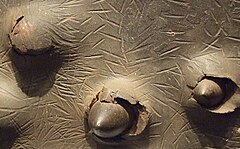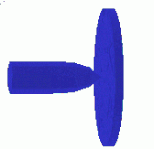
A kinetic energy penetrator (KEP), also known as long-rod penetrator (LRP), is a type of ammunition designed to penetrate vehicle armour using a flechette-like, high-sectional density projectile. Like a bullet or kinetic energy weapon, this type of ammunition does not contain explosive payloads and uses purely kinetic energy to penetrate the target. Modern KEP munitions are typically of the armour-piercing fin-stabilized discarding sabot (APFSDS) type.

Terminal ballistics is a sub-field of ballistics concerned with the behavior and effects of a projectile when it hits and transfers its energy to a target.

A high-explosive squash head (HESH), in British terminology, or a high-explosive plastic/plasticized (HEP), in American terminology, is a type of explosive projectile with plastic explosive that conforms to the surface of a target before detonating, which improves the transfer of explosive energy to the target. Squash head projectiles are similar to high-explosive projectiles and are well suited to many of the same targets. However, while HESH projectiles are not armour-piercing, they can defeat armored targets by causing spall, which can injure or kill a vehicle's occupants or detonate some types of ammunition.

A shell, in a military context, is a projectile whose payload contains an explosive, incendiary, or other chemical filling. Originally it was called a bombshell, but "shell" has come to be unambiguous in a military context. A shell can hold a tracer.

A sabot is a supportive device used in firearm/artillery ammunitions to fit/patch around a projectile, such as a bullet/slug or a flechette-like projectile, and keep it aligned in the center of the barrel when fired. It allows a narrower projectile with high sectional density to be fired through a barrel of much larger bore diameter with maximal accelerative transfer of kinetic energy. After leaving the muzzle, the sabot typically separates from the projectile in flight, diverting only a very small portion of the overall kinetic energy.

The Ordnance Quick-Firing 17-pounder was a 76.2 mm (3 inch) gun developed by the United Kingdom during World War II. It was used as an anti-tank gun on its own carriage, as well as equipping a number of British tanks. Used with the APDS shot, it was capable of defeating all but the thickest armour on German tanks. It was used to "up-gun" some foreign-built vehicles in British service, notably to produce the Sherman Firefly variant of the US M4 Sherman tank, giving British tank units the ability to hold their own against their German counterparts. In the anti-tank role, it was replaced after the war by the 120 mm BAT recoilless rifle. As a tank gun, it was succeeded by the 84 mm 20 pounder.

Armour-piercing discarding sabot (APDS) is a type of spin-stabilized kinetic energy projectile for anti-armour warfare. Each projectile consists of a sub-calibre round fitted with a sabot. The combination of a lighter sub-calibre projectile with a full-calibre propellant charge allows for an increase in muzzle velocity compared to full-calibre rounds, giving the round increased armour-penetration performance. To further enhance their armour-penetration capabilities, APDS rounds typically feature a hardened core made from tungsten or another hard, dense material.

A tank gun is the main armament of a tank. Modern tank guns are high-velocity, large-caliber artilleries capable of firing kinetic energy penetrators, high-explosive anti-tank, and cannon-launched guided projectiles. Anti-aircraft guns can also be mounted to tanks.

The 75 mm gun, models M2 to M6, was the standard American medium caliber gun fitted to mobile platforms during World War II. They were primarily mounted on tanks, such as the M3 Lee and M4 Sherman, but one variant was also used as an air-to-ground gun on the B-25 Mitchell medium bomber aircraft. There were five main variants used during the war: M2, M3, M4, M5 and M6.
The following is a list of ammunition fired by the 125 mm smoothbore gun series used in the T-64, T-72, T-80, M-84, T-90, PT-91, T-14 Armata, and other tanks derived from those designs, as well as the 2A45 Sprut anti-tank gun.
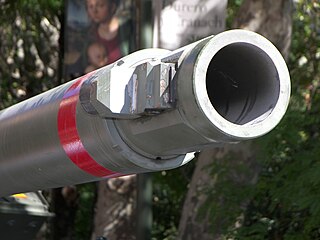
The Rheinmetall Rh-120 is a 120 mm smoothbore tank gun designed and produced in former West Germany by the Rheinmetall-DeTec AG company, it was developed in response to Soviet advances in armour technology and development of new armoured threats. Production began in 1974, with the first version of the gun, known as the L/44 as it was 44 calibres long, used on the German Leopard 2 tank and soon produced under license for the American M1A1 Abrams and other tanks. The 120-millimetre (4.7 in) gun has a length of 5.28 metres (17.3 ft), and the gun system weighs approximately 3,317 kilograms (7,313 lb).
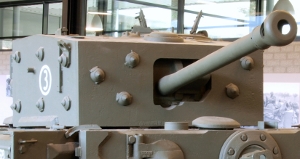
The Ordnance QF 75 mm, abbreviated to OQF 75 mm, was a British tank gun of the Second World War. It was obtained by boring out the Ordnance QF 6-pounder 57 mm anti-tank gun to 75 mm, to give better performance against infantry targets in a similar fashion to the 75 mm M3 gun fitted to the American Sherman tank. The QF came from "quick-firing", referring to the use of ammunition where the shell has a fixed cartridge. The gun was also sometimes known as ROQF from Royal Ordnance Quick-Firing.
Armour-piercing, capped, ballistic capped (APCBC) is a type of configuration for armour-piercing ammunition introduced in the 1930s to improve the armour-piercing capabilities of both naval and anti-tank guns. The configuration consists of an armour-piercing shell fitted with a stubby armour-piercing cap for improved penetration properties against surface hardened armour, especially at high impact angles, and an aerodynamic ballistic cap on top of the AP cap to correct for the poorer aerodynamics, especially higher drag, otherwise created by the stubby AP cap. These features allow APCBC shells to retain higher velocities and to deliver more energy to the target on impact, especially at long range when compared to uncapped shells.

The M829 is an American armor-piercing fin-stabilized discarding sabot (APFSDS) is a kinetic energy penetrator tank round. Modeling was done at the Ballistic Research Laboratory at Aberdeen Proving Ground, which was incorporated into the Army Research Laboratory in 1992. The round is specifically designed for the 120 mm M256 main gun on the Abrams M1A1 and M1A2 main battle tanks. The penetrator is carried by a sabot during its acceleration in the gun barrel.

The Ordnance QF 20 pounder was a British 84 mm (3.307 inch) tank gun. It was introduced in 1948 and used in the Centurion main battle tank, Charioteer medium tank, and Caernarvon Mark II heavy tank. After the 20 pounder gun was found to have inadequate performance against the Soviet T-54 the gun was mostly replaced in service by the larger calibre 105 mm L7 gun.
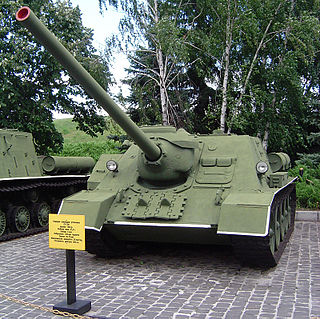
The D-10 is a Soviet 100 mm tank gun developed in late World War II. It originally equipped the SU-100 tank destroyers and was later selected for the T-55 tank, equipping these as late as 1979. On the T-55 the D-10 continues to be in active service in many countries.

Armour-piercing fin-stabilized discarding sabot (APFSDS), long dart penetrator, or simply dart ammunition is a type of kinetic energy penetrator ammunition used to attack modern vehicle armour. As an armament for main battle tanks, it succeeds Armour-Piercing Discarding Sabot (APDS) ammunition, which is still used in small or medium caliber weapon systems.

The Ordnance QF 32 pounder or (32-pdr) was a British 94 mm gun, initially developed as a replacement for the Ordnance QF 17-pdr anti-tank gun.

The Royal Ordnance L11A5, officially designated Gun, 120 mm, Tank L11, is a 120 mm L/55 rifled tank gun design. It was the second 120 mm calibre tank gun in service with British Army. It was the first of NATO's 120 mm main battle tank guns which became the standard calibre for Western tanks in the later period of the Cold War. A total of 3,012 of the L11 guns were produced by 2005. The list price was US$227,000 in 1990.
Stillbrew armour, or more correctly, the Stillbrew Crew Protection Package (SCPP) was an add-on passive composite armour applied to the FV4201 Chieftain main battle tank used by the British Army's Royal Armoured Corps in the mid-1980s and early-1990s so as to provide increased protection from anti-tank warfare weapons. It was named after the two men that invented it, Colonel Still and John Brewer, from the Military Vehicles and Engineering Establishment in Surrey. The tanks to which it was fitted were colloquially referred to as Stillbrew Chieftains.
